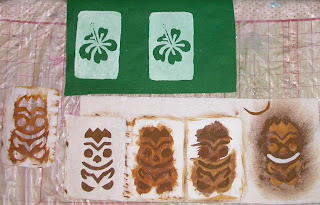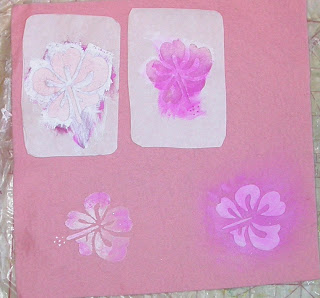 I thought I'd share more of the design images for this year's Camp Quality project (more here) and write up a bit of a tutorial. I'm going to teach this at a meeting in a week or so and it helps me to write it out beforehand.
I thought I'd share more of the design images for this year's Camp Quality project (more here) and write up a bit of a tutorial. I'm going to teach this at a meeting in a week or so and it helps me to write it out beforehand.The top two images on the green were silkscreened using my homemade screen. I tacked good quality organza from J0-Ann's to a small stretcher frame, traced the design with a Sharpie, then filled in the flower petals and outer border with Modge-Podge. As I painted, the "screen" became all wavy and saggy and I didn't hold out much hope.
I let it dry 48 hours and it dried firm and straight so I gave it a go, using a small ruler as a "squeegee." I used cheap acrylics from Jo-Ann's for paint. I squirted a row of paint across the end (on the painted edge, not the open fabric) and pulled it across the open screen with my squeegee. It was partly okay--the squeegee was a bad choice but when I replaced the ruler with an old credit card, I got much nicer results--the card has some flex to it.
When I was done, I washed the screen in cool water. It got all saggy again, but tightened up nicely once dry. So, now I know I can't wash it to change colors and continue without letting it dry.
All of the rest of the imprints in the photos are made using freezer paper stencils. This is a fun technique that you can use to add images or words to anything you can paint (fill the open areas with glue and not paint and coat with gold foil). The paper works okay with felt, although it sticks much better to smooth cotton than it does to fuzzy felt.
Lay your fabric on an ironing surface right side up. Place the cut stencil, with the shiny side down. carefully on top, being sure to allow enough space for your desired margins. Press with a fairly hot iron until the plastic coating on the paper adheres to the fabric. You can't do this ahead of time and come back in a day or so to paint, but need to do it shortly before painting.
I use cheap acrylic paints and 5/$1 sponge brushes. I put some paint on an old, well washed foam meat tray (a paper plate, an old china or plastic plate, or palette paper would all work) and dab the tip of the brush into it. Then I dab the brush onto the open areas of the stencil, moving the brush up and down and not brushing it back and forth. Too much back and forth swiping and you'll pull the freezer paper away from the felt. Sometimes I'll gently swipe from the paper and onto the open fabric, but mostly it's up and down.
Don't use too much paint. Dip your brush in the paint and then tap it a couple of times on an empty area of the palette. A nice effect is to concentrate the paint around the edges of the stencil and let it fade a bit toward the center of the design area.
The row of brown tikis above are a freezer paper stencil pulled off of the design and ready to reuse; the design it was pulled from; two more stenciled designs, ready for the paper to be carefully pulled off for reuse; and a design in reverse.
For this one, I took the pieces I cut out of the stencils and carefully laid them onto my fabric in position, making sure the shiny side was down (this is important because otherwise it will stick to the iron). I pressed them into position and dabbed paint around them. I've pulled the mouth off so you can see the white fabric design that will show when the pieces are removed. I haven't tried to reuse these little bits.
Below are flowers, done in the same technique. The top two are freezer paper stencils with the paper ready to come off. The bottom left is a finished flower with the paper removed. And the bottom right is another reverse stencil. The lighter color paper will be removed to reveal the pink ground fabric.
 To make a freezer paper stencil, pull off a piece of freezer paper (the kind with plastic on one side to protect your food) large enough for your stencil and a nice margin area. For a small design like this, I whack off a piece wide enough for my narrow measurement and then cut two or three pieces across the length of paper to get cut several stencils.
To make a freezer paper stencil, pull off a piece of freezer paper (the kind with plastic on one side to protect your food) large enough for your stencil and a nice margin area. For a small design like this, I whack off a piece wide enough for my narrow measurement and then cut two or three pieces across the length of paper to get cut several stencils.I put it plastic side down onto my design. I made several photocopies of the designs to the proper size. I just place the freezer paper onto the design and cut around the lines using an X-acto knife with a fine blade. I cut carefully so I can use the cut-out bits for reverse stencils.
The layers I work on are a clipboard, a piece of cardboard to protect the clipboard, the photocopy, the freezer paper. That's it. I have always been able to see clearly the photocopied line drawing through the freezer paper without a light box.
I've found I can cut three stencils from one photocopy before it falls apart from being cut. I get a better design if I just cut rather than trying to trace the design and then cut. If you're not comfortable using an X-acto knife, then trace the design and cut it out carefully with fine paper scissors.
Have fun!

